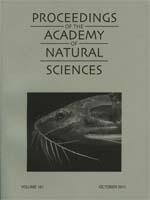Existing phylogenetic hypotheses on the intrarelationships of South American pimelodid catfishes are incompletely resolved and based almost entirely on morphological data. This study analyzed more than seven kilobases of aligned nucleotide sequences from the rag1 and rag2 nuclear genes, and the 12S, 16S and cytochrome b mitochondrial genes for 52 nominal and five undescribed pimelodid species representing 27 of 31 extant genera. Results of Bayesian likelihood and maximum parsimony analyses of the combined sequence data consistently recover 40 monophyletic pimelodid clades above the species level.
The basal lineages of Pimelodidae are Steindachneridion and Phractocephalus that are serially, or together as small clade, sister to all other members of the family. Leiarius and the nominal Perrunichthys perruno are sister to the neopimelodines, a clade comprised of the remaining pimelodids divided into two major lineages: the sorubimines and the Pimelodus ornatus-Calophysus-Pimelodus (OCP) Clade. Sorubimines include seven well-supported units whose interrelationships are poorly resolved: Sorubim, Pseudoplatystoma-Sorubimichthys Clade, tribe Brachyplatystomatini, Platysilurus-Platystomatichthys Clade, Hypophthalmus, Zungaro and Hemisorubim. In conflict with morphological evidence, the molecular data do not support monophyly of the genus Brachyplatystoma. However, the subgenus Malacobagrus (B. rousseauxii, B. capapretum, B. filamentosum) and the sister species pair B. juruense and B. platynemum are each recovered as monophyletic.
The OCP Clade comprises nominal Pimelodus ornatus that is sister to the Calophysus-Pimelodus Clade in turn split into the calophysines and pimelodines. Calophysines include a monophyletic Calophysus Group (Calophysus, Aguarunichthys, Luciopimelodus, Pinirampus, Pimelodina) and the Megalonema-Cheirocerus Group. Intrarelationships of the Calophysus Group recovered with molecular data are congruent with relationships based on morphology. Placement of Cheirocerus sister to Megalonema is unexpected but well supported by molecular data.
Pimelodines include the Exallodontus-Pimelodus altissimus Group and Pimelodus Group. The former correspond to the “long-finned” pimelodids including Exallodontus sister to an undescribed miniature species from the Amazon, and those sister to undescribed species of Propimelodus. An undescribed species related to nominal Pimelodus altissimus is the sister to nominal Duopalatinus peruanus. Nominal Pimelodus pictus is sister to remaining members of the Pimelodus Group that in turn contains three subclades: Iheringichthys plus Parapimelodus, Pimelodus maculatus plus P. albicans, and P. blochii including P. argenteus. Pimelodus coprophagus is unresolved among the P. maculatus and P. blochii groups. A generic reclassification of the species now assigned to polyphyletic Pimelodus is needed based on more complete taxon sampling and character evidence.
A modest sampling of multiple specimens from thirteen pimelodid species permitted a first examination of their genetic diversity within and across the major South American river basins. The rag and mitochondrial genes examined here show little divergence between distant allopatric populations of Pinirampus pirinampu, Brachyplatystoma vaillantii, B. rousseauxii, B. filamentosum and B. juruense. However, specimens representing allopatric populations of five nominal species are as divergent as distinct congeneric species: Pimelodus blochii, P. ornatus, P. pictus, Platysilurus mucosus and Megalonema platycephalum.





